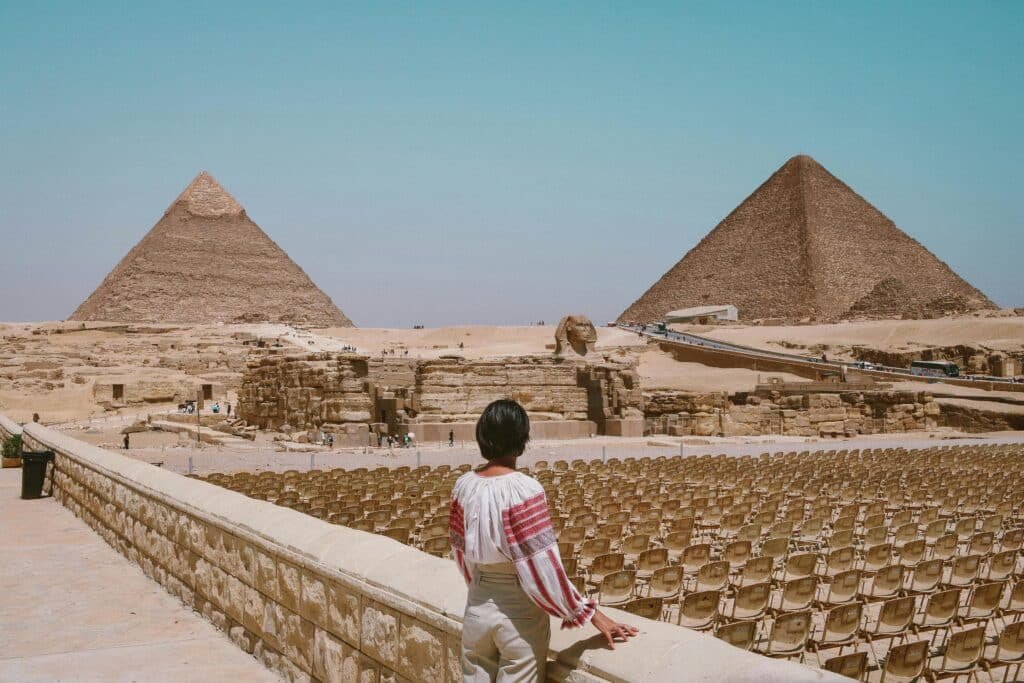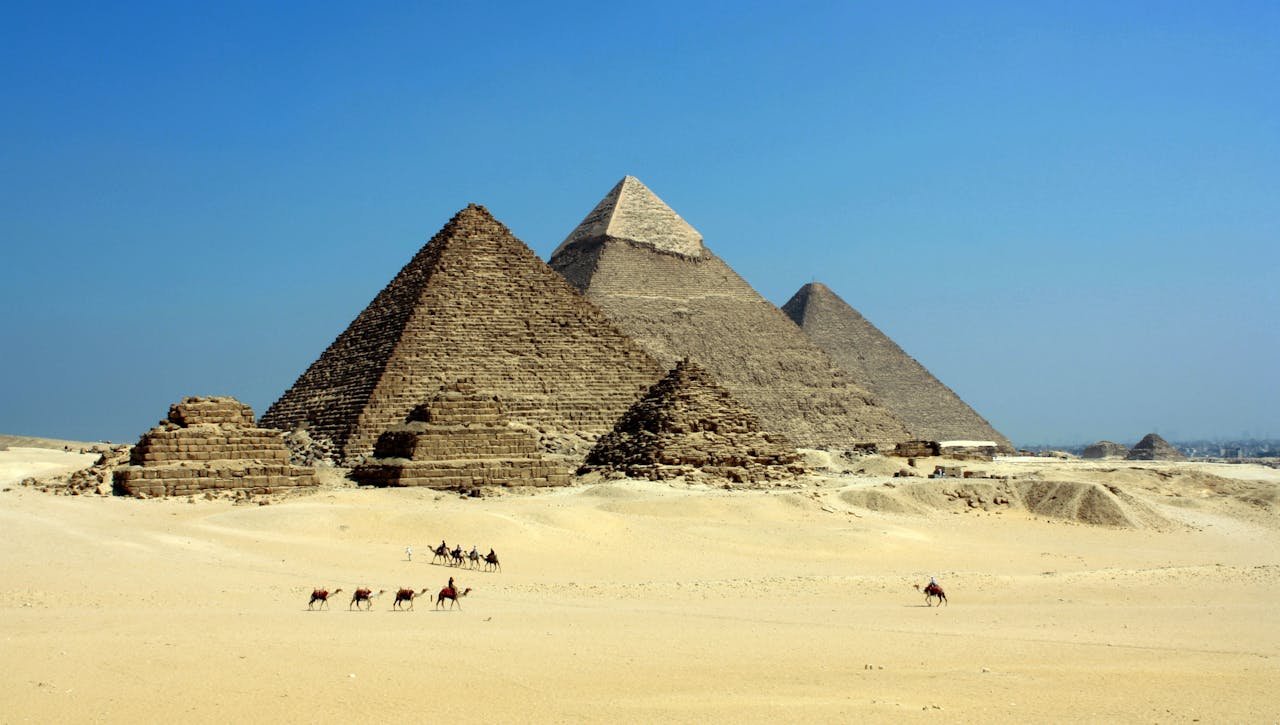The geometry of Great Pyramids in Egypt has grabbed our interest for centuries. The Great Pyramid of Giza is one of the most iconic and mysterious structures in the world. According to the Egyptian authorities, the Great Pyramid was built as a tomb for the pharaoh Cheops 2,500 years ago.
People have been fascinated by its size and accuracy. Let’s take a journey to understand the shapes and designs of ancient Egyptian wonders. We explore the calculations that led to the magnificent structures.
The Significance of the Golden Ratio in Pyramid Construction
The golden ratio is a special number. It is shown by the Greek letter phi (Φ). It means 1.618, which is not a simple fraction. You can find this ratio in galaxy spirals and human body shapes. However, phi is most commonly found in the construction of the Kepler triangle. Experts use it to find the midpoint of a side of the pyramid. In other words, the builders used the golden ratio in the construction around 2560 BC.
In the Great Pyramid, the height and half the base are close to the value of phi. The geometry of Great Pyramids in Egypt is pleasing to look at for a reason. It shows Egyptians might have understood the math idea.
How Pi Influences the Dimensions of the Pyramids
Pi (π) is a number that shows the relationship between a circle’s distance boundary and the diameter. Initially, the pyramid’s base connects to its height. As a result, it makes a number that is very close to pi. Thus, the builders created a right angle.
The angle is at the arc of a semi-circle. Furthermore, the circumference is equal to the perimeter of the Great Pyramid. Clearly, builders constructed the pyramids with geometry. They knew about the golden ratio and the Pythagorean theorem. In short, they had a complete grasp of the mathematical concepts.
Read More Here: All Civilizations History Timeline
The Architectural Genius Behind Pyramid Alignment
The four sides of the Great Pyramid face almost exactly north, south, east, and west. The careful direction toward the stars shows they knew about astronomy. Moreover, it also shows they wanted to connect with the cosmos. Also, the line reflects time, seasons, and celestial cycles. As a result, the builders had skills with knowledge of the skies.
Moreover, the Diary of Merer is a famous logbook from an Egyptian official. It shows the details. Experts learned how the workers transported limestone blocks from Tura to Giza. In addition, the logbook confirms an organized workforce according to the size of the pyramid.
The geometry of Great Pyramids faces True North
One big mystery about the Great Pyramids is how well they are lined up with the true north. Therefore, there are many theories about it.
Some people think the builders used the stars, especially the North Star. As a result, the pyramids aligned with the pyramids. However, others believe they measured shadows. Also, the builders looked at the sun. They knew about the solar cycles.
The Role of Astronomy in the Geometry of Great Pyramids
The ancient Egyptians had a great respect for the sky. Moreover, they were very interested in stars and astronomy. Also, they learned about the cosmos in many parts of their lives. The sky was more than just a pretty sight. Instead, it was a part of their beliefs and constructions.
An example of this is how the pyramids are lined up in all main directions. In other words, the pyramids were not just tombs for the dead but might have been used as large calendars or observatories as well.
Additionally, the builders understood the world and the world above them. The final resting places of the pharaohs helped them connect with the stars.
Amazon Best Reviewed Book- The Mathematics of Pyramid Puzzles
Understanding the Geometry of Great Pyramids
The Great Pyramid may look simple. However, they involve a smart mix of basic shapes. Each part keeps them stable.
Initially, the bottom of the pyramid is a square base. It stands with the Earth and gives strong support.
Next, four triangular sides meet at the top point. The triangles point upwards. As a result, it shows the Egyptians’ belief that the spirit of the pharaoh rises to the sky. In other words, the square and triangle together are the link between the Earth and the heavens.
The choices are not random. They show a solid grasp of geometry. The Egyptians understood the strength in the shapes. As a result, the pyramids have stood proudly for centuries.
The Constant Gradient found in the geometry of Great Pyramids
The geometry of Great Pyramids begins with the internal design. They had passageways and chambers. It shows how skilled the builders were in creating a consistent slope. The incline lasts over long distances. In other words, the builders were masters in engineering, angles, and elevation.
Moreover, keeping a steady slope needs a lot of planning. The Egyptians probably used advanced tools. They may have had plumb bobs. Also, the builders could have used measuring rods and leveling tools. At the same time, they kept the Theory of Gravity in mind.
Additionally, the constant gradient helped move materials. The Egyptians blended function with meaning very well.
How geometry of Great Pyramids inspired other Cultures?
The pyramids suggest that different cultures may have had similar building ideas. Moreover, they shared the same knowledge. Even though they were very far apart, the societies created something similar.
For example, the pyramids in Mesoamerica and Teotihuacan in Mexico use large stone blocks. The builders cut and joined the rocks without glue. Subsequently, the ideas spread through trade or sea.
Also, some researchers believe a connection exists with Platonic solids in the pyramid designs. The geometry of the Great Pyramid shows cultures might have learned from one another. Over time, the knowledge led to research in ancient times.

The Influence of Egyptian Geometry on the Great Pyramids
Undoubtedly, the ancient Egyptians had a big impact on geometry. The geometry of Great Pyramids affected buildings and ideas in later cultures. The Greeks continued with their philosophy after learning from the Egyptians.
Famous thinkers like Thales and Pythagoras studied in Egypt. They learned about math and astronomy. Later, they shape their ideas. Over time, the concepts became a huge part of Western thinking.
The Greek philosopher Plato included Egyptian geometric ideas in his writings. In Timaeus and Critias, he suggested that geometric rules connect to the universe’.
Best Book is available here: Pyramid in the Mountain
Modern Interpretations and Theories of Pyramid Geometry
Experimental archaeology projects
Foremost, teams try to move and lift heavy stone blocks with levers, rollers, and ramps. They are simulating the geometry of Great Pyramids.
Scale model constructions
Secondly, researchers make smaller versions of pyramids. They test various construction techniques. Moreover, they use different materials to learn about the challenges.
Computer simulations
Advanced software helps researchers create virtual models of the building process. Firstly, the programs create different ideas. Next, they ran the software to learn how the Egyptians managed labor and resources. The creativity is based on the geometry of Great Pyramids.
Buy From Amazon- Questions, Facts, and Uncomfortable Thoughts About the Pyramids of Giza
Egyptian Pyramids in Today’s Architecture
A great example is the Louvre Pyramid in Paris. I.M. Pei designed the structure that is made of glass. Moreover, the metal blends represent ancient and modern styles. It is the main entrance to the museum.
Another interesting example is the Walter Pyramid in Long Beach, California. It serves as the home for the Long Beach State University basketball team. The unique building shows new ideas in stadium design.
Amazon Book- The Pyramid
Which tools are common in the geometry of Great Pyramids?
| Tool/Technique | Description |
| Copper tools | For quarrying and shaping stone blocks. The Egyptians had limited knowledge of metallurgy and toolmaking. |
| Levers and rollers | To move and maneuver heavy blocks. They knew about basic mechanics and leverage. |
| Ramps and earthen inclines | To transport blocks up the pyramid’s structure. It reduced the vertical force for lifting. |
| Wooden sleds and ropes | To move blocks over land. The builders used water to reduce friction. |
The Cultural Significance of Pyramids Beyond Geometry
People saw the pharaoh as a link between the gods and people. The design of the pyramids was meant to help the pharaoh’s soul reach a better afterlife. Thus, they represented the Egyptians’ views on the afterlife. It shows the key place of pharaohs in the society. The pyramids represent power and legacy.

Pyramids as a Symbol of Technological and Spiritual Achievements
The pyramids are strong symbols of technology and spirituality. They show the height of the skills in building. Moreover, the geometry of Great Pyramids shows the ability to accomplish great projects.
The large size and exact shape show knowledge of mathematics, geometry, and astronomy. Moreover, it is a concept of using geometry to keep order. Other civilizations will value the thinking throughout the Middle Ages.
The Role of Pyramids in Ancient Egyptian Society
In ancient Egypt, pyramids were very important. They were more than just royal tombs. Building the tombs took a lot of resources and workers. However, the big projects helped bring people together. In addition, they showed the of the pharaoh and the teamwork of the Egyptian people.
Secondly, building the pyramids also changed society. It helped people learn specialized skills and improved social organization. Also, the Egyptians developed complex engineering methods. The geometry of Great Pyramids kept them busy.
Furthermore, they were also important for religious events and pilgrimages. The tomb improved the bond between the divine status and the people. So, the pyramids were more than their physical shape. They were home to politics and religion in ancient Egypt.
Buy Lost in a Pyramid or the Mummy’s Curse from Amazon
Interactive Learning: Constructing Your Pyramid Model
DIY Pyramid Building: Materials and Methods
First, pick what you want to use for your pyramid. You can use cardboard, foam board, sugar cubes, or wooden blocks. After picking your material, decide the size you want the base of your pyramid. Next, cut the pieces. To create a classic pyramid, cut out four identical triangles. Moreover, you will need one square base.
Next, put the pyramid together. Attach the triangle sides to the square base with glue, tape, or toothpicks. The choices matter on the material. Make sure the edges line up correctly to create the special shape of a pyramid. You can also make your model better. Furthermore, paint it and add texture. You can even make rooms inside.
Educational Benefits of Pyramid Projects
Engaging with pyramid projects provides many educational benefits for people of all ages.
The projects turn theory into real-life work. It teaches you about the geometry of Great Pyramids. Also, you learn about engineering and ancient civilizations better. Next, building a pyramid model is more than just memorizing facts. It allows people to use concepts practically. As a result, you improve understanding and problem-solving skills.
Making a pyramid model involves knowing basic shapes. Moreover, you learn more about squares and triangles. It shows how the shapes fit together to create a three-dimensional structure.
The activity teaches you about reasoning. Furthermore, you think about and plan how to build. Furthermore, you will face the challenges of putting together a smaller version. As a result, it will help you appreciate complex engineering.
Additionally, these pyramid projects are part of history lessons, art classes, and STEM education. They offer a real link to ancient civilizations and create a strong interest in history. Furthermore, you learn about architecture and the cleverness of the past.
Finally, individuals improve their critical thinking and creativity. They also gain a deeper appreciation for how different areas of knowledge connect.
Buy From Amazon: A Miracle in Stone, Or the Great Pyramid of Egypt
Please choose display type!The Future of Pyramid Studies
Time travels at the speed of light. However, the study of pyramids looks promising. Experts use scanning tools and study old texts. They are trying out new archaeological methods to find hidden chambers. Soon, we will learn how the pyramids were built.
As technology grows, we can expect new and exciting findings in pyramid research. Better tools could find hidden rooms. Moreover, we might discover more about the pieces inside that we already know about. It can change our understanding of the ancient buildings.
What did you learn about the geometry of Great Pyramids?
The Great Pyramids of Egypt show us how smart the ancient builders were with math and design. They used shapes and rules like the golden ratio and pi to build amazing structures. Undoubtedly, no one can match their balance and accuracy. The pyramids will have lasting value in our history.









